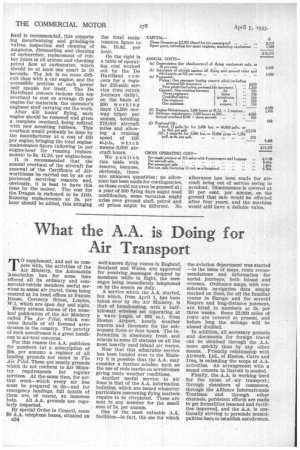What the A.A. is Doin
Page 56

If you've noticed an error in this article please click here to report it so we can fix it.
Air Transport
01) (
for
T0 supplement, and not to compete with, the activities of the Air Ministry, the Automobile Association has for some time offered all its ordinary and commercial-vehicle members useful services to assist air travel, these being centred at its head offices at Fanuna House, Coventry Street, London, W.1, which are open day andnight. Every airman knows of the looseleaf publication of the Air Ministry called The Air Pilot, which contains details of all licensed aerodromes in the country. The paucity of such aerodromes is a great handicap to air-taxi concerns. For this reason the A.A. publishes for members (at a subscription of 30s. per annum) a register of all landing grounds not noted in The Air Pilot. These are mostly grounds which do not conform to Air Ministry requirements for regular services. At the same time, for airtaxi work—which every air line must be prepared to do—and for emergency landings, full details of them are, of course, an immense help. All A.A. grounds are regularly inspected. By special Order in Council, some 80 A.A. telephone boxes, situated on c34 well-known flying routes in England, Scotland anti Wales, are approved for receiving messages dropped by members while in flight, the messages being immediately telephoned on by the scouts on duty. A service which the A.A. started, but which, from April 1, has been taken over by the Air Ministry, is that of broadcasting, with a halfkilowatt wireless set (operating at a wave length of 833 m.), from Heston Airport, hourly weather reports and forecasts for the subsequent three or four hourS. The information is absolutely fresh and relates to some 27 stations on all the most heavily used inland air routes. Now that this admirable service has been banded over to the Ministry it is possible that the A.A. may consider a further scheme, such as the use of code marks on aerodromes giving route weather conditions. Another useful service to air lines is that of the A.A. information bulletins, which are issued whenever particulars concerning flying matters require to be circulated. These are sent to any member for the small sum of 5s. per annum. One of the most valuable A.A. facilities—in fact, the one for which the aviation apartment was started —is the issue of maps, route recommendations and information for aerial journeys, both inland and oversea. Ordnance maps, with considerable navigation data simply marked on them, for all the familiar routes in Europe and for several Empire and long-distance journeys, are hired to members at 5s. per three weeks. Some 22,000 miles of route are covered at present, and before long the mileage will be almost doubled. In addition, all necessary permits and documents for foreign travel can be obtained through the A.A. more quickly than by any other means. Friendly relationship with Airwork, Ltd., of Heston, Cairo and Iraq, is extending the scope of A.A. activities. An arrangement with a sound concern in Nairobi is needed. Finally, the A.A. is working hard for the cause of air. transport; through chambers of commerce, through the Alliance Internationale Tourisme and through other channels, persistent efforts are made to get formalities lessened and facilities improved, and the A.A. is continually striving to persuade municipalities here to establish aerodromes.












































































































